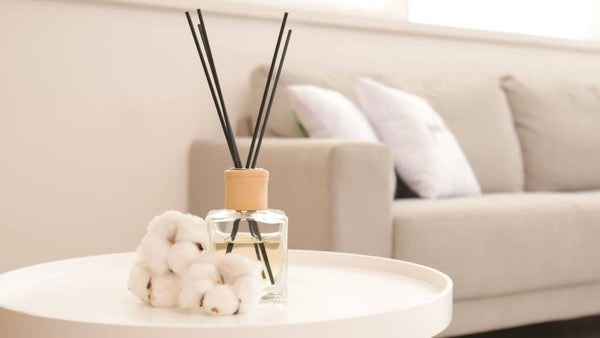Introduction To The Ultimate Guide to Scented Wax Melts
Do we know scented wax melts? Of course we do! After many years of creating and using various types of melts, we’re happy to share our expertise in this ultimate guide to scented wax melts. We'll explore all things related to wax melts - from their history and types to their benefits and how to use them effectively. So let’s get right to it.
What are Wax Melts?
Wax melts, also known as wax tarts or wax cubes, are fragrant pieces of wax designed to be gently heated to release their scents. Unlike candles, they don't have a wick and are not burned, but rather melted in a special warmer. They come in a wide variety of scents and are a popular choice for those who love to fill their homes with delightful fragrances.
The Science of Wax Melts
Wax melts work on a simple principle: heat turns solid wax into a liquid, which then evaporates into the air, carrying the fragrance with it. This process is called volatilization. As the wax melts, it releases aromatic oils that are mixed into the wax during production. These oils, when heated, diffuse into the air, filling your home with a pleasant scent.

Different Types of Wax Melts
There are several types of wax melts available, each with its own unique properties. Some of the most common ones include soy wax melts, and paraffin wax melts. Soy wax melts are known for their long-lasting scent and eco-friendly properties, while paraffin wax melts are popular for their strong scent throw.
Benefits of Wax Melts
Wax melts offer several benefits over traditional candles. They're safer as they don't require a flame, reducing the risk of fire accidents. They're also more economical since you can control the amount of scent released by adjusting the amount of wax used. Plus, with wax melts, you can mix and match scents to create your own unique fragrance.
The History of Wax Melts
Wax melts, despite their recent surge in popularity, have a relatively short history compared to their candle counterparts. The creation of wax melts came about as an innovative solution for chandlers, the old English term for candlemakers, who were looking for ways to utilize their leftover wax from candle making.
This ingenious idea allowed the chandlers to reduce waste while creating a new product that would eventually become a staple in many homes. Unlike candles, which have a history spanning around 5,000 years, wax melts are a more modern invention.
The exact year of the wax burner's origin isn't well-documented, but it is known that the use of paraffin wax in these products was introduced by Herman Frasch. This type of wax became a popular choice for wax melts due to its ability to hold and release fragrance well.
Over time, wax melts have not only become a resourceful use of leftover wax but also a preferred method of home fragrancing for many. They offer a flameless alternative to candles, reducing the risk of accidental fires. Moreover, they come in a wide array of scents, allowing for a customizable fragrance experience.

From their practical beginnings to their current status as a popular home fragrance option, wax melts have certainly made their mark in the world of home fragrances. Their history may be brief compared to candles, but their impact is considerable and continues to grow.
The Origins of Scented Wax
The origin of scented wax can be traced back to the ancient Greeks who started adding spices and herbs to their candles to produce a pleasant aroma. This practice was later adopted by the Romans and eventually spread across Europe.
Evolution of Wax Melts Over the Years
In the 1990s, wax melts started to gain popularity as an alternative to traditional candles. Initially, paraffin wax was predominantly used in the creation of wax melts. However, with growing environmental consciousness and health concerns related to the use of paraffin, other types of waxes like soy and coconut wax have gained popularity. Today, wax melts come in a variety of shapes, sizes, and fragrances, and are appreciated for their ease of use and flameless operation.
Understanding the Ingredients in Wax Melts
Wax melts are typically made from a blend of wax and fragrance oils. The type of wax used can vary and includes paraffin, soy, beeswax, and coconut wax. Fragrance oils, which can be either synthetic or natural, are mixed into the wax to create the desired scent. Some wax melts may also contain dyes to give them a distinctive color. It's important to note that high-quality wax melts usually contain non-toxic, allergen-free, and phthalate-free ingredients.
Benefits of Soy Wax Melts
Soy wax melts offer several benefits, making them a popular choice among consumers. Here are some reasons why you might consider choosing soy wax melts:
-
Non-Toxic: Unlike paraffin wax, soy wax is non-toxic, making it better for both your health and the environment.
-
Longer Burn Time: Soy wax has a lower melting point than paraffin wax, which means it burns slower and lasts longer.
-
Eco-Friendly: Soy wax is made from renewable resources, while paraffin wax is derived from petroleum, a non-renewable resource.
-
Cost-Effective: Despite their higher upfront cost, the longer burn time of soy wax melts makes them more cost-effective in the long run.

Benefits of Coconut Wax Melts
Coconut wax melts are another great option for scenting your home. While they may be less common than soy or paraffin wax melts, they offer unique benefits:
-
Long Burn Time: Like soy wax, coconut wax also has a lower melting point, resulting in a longer burn time.
-
Clean Burning: Coconut wax is known for its clean burn
-
Strong Scent Throw: Coconut wax holds a high volume of fragrance, and its slow burn rate allows for an excellent scent throw for a natural wax
-
Sustainable: Coconut wax is a sustainable and renewable resource, making it an eco-friendly choice.
Coconut Soy: The Best Wax Melts
A blend of coconut and soy wax often makes the best wax melts. This combination harnesses the strengths of both waxes - the long burn time and clean burn of soy wax, and the strong scent throw of coconut wax. These blends are also more eco-friendly than paraffin wax melts, making them a popular choice for environmentally conscious consumers.
How to Use Wax Melts - Melting Wax Cubes
Using wax melts is simple and straightforward. Here's a step-by-step guide:
-
Choose your wax melt: Start by choosing the scent you want. As mentioned earlier, you can mix and match different scents to create a unique fragrance.
-
Place the wax melt in the warmer: Break off a piece of the wax melt and place it in the dish of the wax warmer. If the wax melt is too large for the dish, you can cut it into smaller pieces.
-
Turn on the warmer: Plug in the wax warmer and turn it on. The heat will cause the wax to melt and release its scent into the air.
-
Enjoy the fragrance: Sit back and enjoy the delightful aroma filling your room. The scent from a wax melt can last anywhere from 8 to 12 hours depending on the type of wax used and the strength of the fragrance.
-
Clean up: Once the scent has dissipated, turn off the wax warmer and allow the wax to cool and harden. Once hardened, you can easily remove it and clean the dish before using a new wax melt.
Tips for Using Scented Wax Melts
-
Use the right amount of wax: If you're new to wax melts, start with a small amount and gradually add more if you want a stronger scent.
-
Clean the wax warmer regularly: Regular cleaning ensures that the scent of the wax melt is not tainted by residue from previous melts.
-
Store wax melts properly: Keep your wax melts in a cool, dry place away from direct sunlight to preserve their scent.
-
Safety first: Never leave a wax warmer unattended when it's on. Also, keep it out of reach of children and pets.
Choosing the Right Wax Warmer
Choosing the right wax warmer depends on your specific needs and preferences, but here are a few things to consider:
-
Type of Warmer: There are two main types of wax warmers - electric and tea light. Electric warmers use a heating element to melt the wax, while tea light warmers use a tea light candle. Electric warmers are generally considered safer, but tea light warmers can provide a cozy ambiance.
-
Size: The size of the warmer's dish will determine how much wax you can melt at once. If you like stronger scents or have a larger room, you might want a warmer with a larger dish.
-
Style: Wax warmers come in a variety of styles, from modern and sleek to rustic and traditional. Choose a style that fits well with your home decor.
-
Safety Features: Look for features like automatic shut-off and a stable base to ensure safe operation.
-
Price: Wax warmers can range in price, so consider your budget when making your choice.

Wax Melt Safety Tips
While wax melts are safer than traditional candles, there are still some safety tips to keep in mind:
-
Never Leave a Warmer Unattended: While they may not have an open flame, wax warmers can still pose a fire risk if left unattended.
-
Keep Out of Reach of Children and Pets: Make sure your warmer is in a safe location where children and pets can't knock it over or touch the hot wax.
-
Use Heat-Resistant Surfaces: Always place your warmer on a heat-resistant surface to prevent damage to your furniture or countertops.
-
Don't Overfill Your Warmer: Overfilling your warmer's dish can lead to spilled wax or a weaker scent throw. Always follow the manufacturer's instructions for how much wax to use.
-
Turn Off When Not In Use: Remember to turn off your warmer when you're not using it to conserve energy and prolong the life of your warmer.
Health and Safety Concerns with Scented Wax Melts
When it comes to the health and safety of using wax melts, there are several factors to consider. The type of wax used, the fragrance oils, and how they are used can all affect their safety.
Are Wax Melts Toxic?
Whether or not wax melts are toxic largely depends on the ingredients used. Paraffin wax melts scented with synthetic fragrances are considered potentially harmful because they can release chemicals such as benzene when heated. On the other hand, wax melts made from natural waxes like soy or coconut and scented with natural essential oils, or phthalate free fragrances are typically considered non-toxic and safe.
It's important to note that even non-toxic wax melts should be used in a well-ventilated area to prevent any possible adverse effects from inhaling the scent too strongly.
Potential Allergies and Sensitivities to Wax Melts
Some people may have allergies or sensitivities to certain scents or ingredients in wax melts. Symptoms can include headaches, nausea, or respiratory issues. If you notice any adverse reactions when using wax melts, discontinue use and consider seeking medical advice.
To minimize potential allergies and sensitivities, opt for wax melts made from natural ingredients, and avoid those with strong, overpowering scents. Additionally, you might want to start with a small amount of wax to see how you react before using a full melt.
Remember, while wax melts are a popular way to fragrance your home, they should always be used safely and responsibly.
The Art of Choosing Wax Melt Scents
Choosing wax melt scents can be an art in itself. It's not just about picking a scent you like, but also understanding how different scents can affect your mood and atmosphere.

Understanding Fragrance Notes
Fragrances are typically composed of three types of notes: top, middle, and base notes.
Top Notes: These are the first scents you smell when experiencing a fragrance. They are usually light and evaporate quickly.
Middle Notes: Also known as heart notes, these emerge once the top notes dissipate. They are more balanced and make up the main body of the scent.
Base Notes: These are the last to develop and linger the longest. They add depth and complexity to the fragrance.
Understanding these notes can help you choose a wax melt that evolves in scent over time, providing a unique and enjoyable experience.
Best Scents for Relaxation
Lavender, chamomile, and vanilla are often associated with relaxation and sleep. These soothing scents can help reduce stress and anxiety, making them perfect for use in the evening or before bed1.
Best Scents for Energy and Focus
Citrus scents like lemon, orange, and grapefruit are known for their energizing properties. Similarly, mint and rosemary can help improve focus and concentration.
How to Pair Wax Melt Scents
Pairing wax melt scents can create a unique fragrance experience. Here are a just a few pairing ideas of the many available:
-
Floral and Citrus: This combination creates a fresh, uplifting scent. Try pairing lavender with lemon or jasmine with grapefruit.
-
Woody and Spicy: For a warm, cozy atmosphere, pair a woody scent like sandalwood with a spicy scent like cinnamon.
-
Fruity and Minty: For a refreshing, invigorating scent, pair a fruity scent like berry with a minty scent like peppermint.
Can Different Wax Melts Be Used Together?
Yes, different wax melts can be used together to create your own unique fragrance combinations. This is known as "mixing melts" or "fragrance layering." However, it's important to ensure the scents complement each other to avoid creating an overwhelming or unpleasant aroma.
Do Wax Melt Scents Affect Mood?
Scientific studies have shown that certain scents can affect mood, stress levels, sleep patterns, self-confidence, and even physical health2. For example, lavender is often associated with relaxation and stress relief, while citrus scents are usually linked to increased energy and alertness.

Seasonal and Occasional Wax Melts
Seasonal and occasional wax melts offer an excellent way to celebrate different times of the year and special occasions. These scents are usually tailored to evoke specific seasons or events, providing a sensory experience that enhances the ambiance of your home.
Best Wax Melts for the Holiday Season
The holiday season is a perfect time to indulge in festive wax melt scents. Here are a few popular options:
-
Cinnamon: This warm, sweet, and slightly spicy scent is often associated with holiday baking and mulled wine, making it a popular choice for the Christmas season.
-
Pine: The smell of fresh pine is synonymous with Christmas. It’s reminiscent of a freshly cut Christmas tree and can instantly create a festive atmosphere in your home.
-
Peppermint: Sweet and refreshing, peppermint is a classic holiday scent. It’s often associated with candy canes and other holiday treats.
-
Gingerbread: While technically a blend of several spices, the distinct smell of gingerbread is a holiday favorite. It's associated with baking and decorating gingerbread cookies and houses.
-
Orange: The zesty smell of oranges is often associated with the holiday season. It's a bright, uplifting scent that can add a touch of freshness to your home.

Celebrating Special Occasions with Wax Melts
Wax melts can also help set the mood for special occasions throughout the year:
-
Birthdays: Consider fun, festive scents like vanilla baked goods to celebrate a loved one's special day.
-
Valentine's Day: Romantic scents like rose, champagne, or chocolate-covered strawberries can create a lovely atmosphere for a date night at home.
-
Spring Cleaning: Refreshing and invigorating scents like lemon, mint, or fresh linen can help motivate you during a spring cleaning session.
-
Summer Parties: Tropical scents like coconut, pineapple, or ocean breeze can complement a summer barbecue or pool party.
No matter the occasion, there's a wax melt scent to match. By choosing seasonal and occasional wax melts, you can create a constantly changing and atmospheric scent experience in your home.
Wax Melts vs Other Home Fragrances
When it comes to home fragrances, there are several options to choose from. Each has its unique features and benefits. Let's compare wax melts with some other popular home fragrance options.
Wax Melts vs Candles
Both wax melts and candles can fill your home with delightful scents, but they have some key differences:
Safety: Wax melts are generally considered safer as they don't require an open flame to work. Instead, they use a low-wattage bulb or low-temperature electric heater.
Scent Duration: Wax melts often last longer than candles. A single wax melt can emit fragrance for up to 10 hours.
Customization: With wax melts, you have the freedom to mix and match different scents to create your unique aroma.
Wax Melts vs Essential Oil Diffusers
Essential oil diffusers and wax melts both offer a wide variety of scents, but their usage and effects can vary:
Health Benefits: Essential oils are often used for their therapeutic properties. For example, lavender oil can promote relaxation, while peppermint oil can boost energy.
Intensity of Scent: Wax melts can produce a stronger scent, making them a better choice for larger rooms or spaces.
Maintenance: Essential oil diffusers may require more cleaning between uses compared to wax warmers.

Wax Melts vs Incense Sticks
Incense sticks and wax melts both provide aromatic experiences, but they differ in several ways:
Smoke Production: Incense sticks produce smoke and can leave ash residue, which some people may find bothersome. Wax melts, on the other hand, do not produce smoke.
Duration of Scent: Wax melts typically last longer than incense sticks, providing a continuous fragrance for up to 8-12 hours.
Variety of Scents: While both offer a wide range of fragrances, wax melts often have a broader and more varied selection of scents.

Aromatherapy Wax Melts
Aromatherapy wax melts are designed to fill your space with therapeutic aromas that can enhance your mood, relieve stress, and create a peaceful atmosphere. They are a natural, safe, and cost-effective way to enjoy the benefits of aromatherapy at home.
Best Wax Melt Scents for Aromatherapy
Certain scents are known for their therapeutic properties. Here are some of the best wax melt scents for aromatherapy:
-
Lavender: Known for its calming properties, lavender is perfect for promoting relaxation and aiding sleep.
-
Eucalyptus: Eucalyptus has a refreshing aroma that can clear the mind and promote concentration.
-
Peppermint: Peppermint's invigorating scent can boost energy levels and improve focus.
-
Lemon: Lemon, with its clean, citrusy aroma, is known to uplift mood and reduce anxiety.
-
Sandalwood: Sandalwood's warm, woody scent can help reduce tension and promote a sense of well-being.

Wax Melt Care and Tips
Proper care and storage of your wax melts can ensure they last longer and deliver the best fragrance experience. Let’s see how we can implement this.
How To Store Wax Melts
Here are some tips for storing wax melts:
-
Keep in a Cool, Dark Place: Exposure to light and heat can degrade the scent of the wax melts. Store them in a cool, dark place to maintain their fragrance.
-
Use Airtight Containers: Store your wax melts in airtight containers to prevent them from absorbing other odors.
-
Avoid Stacking Different Scents: If possible, avoid stacking different scented wax melts together. The scents can mix, altering their original fragrance.
By properly storing your wax melts, you can preserve their quality and enjoy their delightful scents for longer. So why not take the time, it just makes scents (you see what I just did there).
Wax Melts: Practical Considerations
While wax melts are a wonderful way to fill your home with delightful scents, there are some practical considerations to keep in mind. Here's how to handle some common situations.
How to Clean Up Spilled Wax Melts
Accidents happen. If you spill melted wax, here's how you can clean it up:
-
Let the Wax Cool: Allow the spilled wax to harden. It's much easier to clean up wax once it's solidified.
-
Scrape Off Excess Wax: Use a plastic scraper or a similar tool to gently remove as much of the wax as possible.
-
Apply Heat: For wax that has soaked into fabric, place a paper towel or a brown paper bag over the spilled wax and apply heat with an iron. The heat will melt the wax, and the paper will absorb it.
Can Wax Melts Be Recycled or Reused?
Wax melts can be reused until they no longer emit any fragrance. Once the scent is gone, you can consider recycling the wax. However, not all recycling facilities accept wax, so it's important to check with your local waste management facility.
Another option is to repurpose the wax for DIY projects, like homemade candles or fire starters.
How to Remove Wax Melts from Warmer
When it's time to change your wax melt, follow these steps:
-
Turn Off the Warmer: Always switch off and unplug your warmer before changing the wax melt.
-
Let the Wax Cool: Allow the wax to cool and harden. This makes it easier to remove.
-
Push the Wax Out: Most warmers are designed to allow you to push the hardened wax out from the bottom. If this isn't possible, you could use a scraper or butter knife to gently loosen the wax.
The Environmental Impact of Wax Melts
Wax melts, like any other product, have an environmental impact. However, their effect on the environment largely depends on the type of wax used and how they're used.
Are Wax Melts Eco-Friendly?
Wax melts are often considered more eco-friendly than candles. They don't produce soot, and when used with an electric warmer, they can be flame-free. This reduces the risk of fires, which, according to the National Fire Protection Association, caused an estimated $278 million in direct property damage from 2014-2018.
The environmental friendliness of wax melts also depends on the type of wax used. Vegetable waxes like soy, coconut, or rapeseed are renewable and biodegradable, making them a more sustainable choice over paraffin wax, a petroleum by-product.
Sustainable Practices in Wax Melt Production
Many manufacturers are adopting sustainable practices in wax melt production. Using vegetable-based waxes, recyclable packaging, and ethically sourced ingredients are some ways companies are reducing their environmental footprint.
The Future of Wax Melts
As consumers become more eco-conscious, the future of wax melts looks promising for consumers, the industry, as well as the environment.
Trends in Home Fragrances
Home fragrance trends are shifting towards sustainable and natural products. As wax melts are often made from natural ingredients and produce little waste, they align with these trends.
Sustainability and Wax Melts
The sustainability of wax melts will continue to be a focus. With more consumers demanding environmentally friendly products, manufacturers will likely continue to innovate and improve the sustainability of their products.
Innovations in Wax Melt Technology
Innovations in wax melt technology are expected to further reduce their environmental impact. For instance, biodegradable packaging and energy-efficient warmers are potential areas for innovation.
Wax Melts and Pets: What You Need to Know
Navigating the world of home fragrances can be a challenge, particularly when we consider the health and safety of our furry friends. With wax melts gaining popularity for their ease of use and variety of scents, it's essential to understand how these products might affect pets.

Are Wax Melts Safe to Use Around Pets?
Generally, wax melts are safe to use around pets when used correctly. However, this doesn't mean they're entirely risk-free. The type of wax and the fragrances used can have varying effects on pets.
For instance, some types of wax, like those made from soy or vegetables, are non-toxic and won't cause harm if a pet happens to lick it. However, waxes scented with essential oils, even if they're soy or vegetable-based, may not be pet-safe due to issues with certain essential oils. Similarly, paraffin wax and low quality artificial fragrances can negatively affect your pet's health. Phthalate free is definitely the way to go.
Pets, like humans, can have sensitivities or allergies to certain scents. If a scent is strong and overwhelming, it could potentially irritate your pet, especially if they have nowhere to escape from the fragrance. Symptoms of irritation can include sneezing, coughing, or other respiratory issues.
Can Wax Melts Harm Dogs or Cats?
While wax melts themselves aren't inherently harmful to dogs or cats, certain ingredients in them can be. As mentioned earlier, paraffin and low quality artificial fragrances are two components that can negatively impact a pet's health.
In general, it's always best to monitor your pet when using a new wax melt for the first time. Look for signs of discomfort or irritation, such as sneezing, coughing, or changes in behavior. If you notice any adverse reactions, stop using the wax melt immediately and consider consulting with a vet.
Remember, safety should always come first when it comes to our pets. So, when using wax melts or any fragranced product, always ensure there's adequate ventilation, and never leave the product unattended. This way, you can enjoy a beautifully scented home while also keeping your furry friends safe.
Frequently Asked Questions about Wax Melts
Wax melts are a popular choice for home fragrance, but many people have questions about how to use them properly. Here are some common queries:
How Long Do Wax Melts Last?
The longevity of a wax melt's scent can vary depending on its quality and type. High-quality wax melts can last anywhere from 8 to 12 hours, while others may only last a few hours. The strength and quality of the fragrance oil used in the wax melt also plays a significant role.
Can You Mix Wax Melt Scents?
Yes, you can mix wax melt scents to create your unique fragrance blend. Simply place different wax melt cubes in your warmer at the same time. As they melt, the scents will combine. Experiment with different combinations to find your perfect mix.
Can You Leave Wax Melts on Overnight?
While it might be tempting to leave your wax melts on overnight for continuous fragrance, it's generally not recommended for safety reasons. Leaving a wax warmer on for extended periods can pose a fire risk or cause the warmer to overheat. Always follow the manufacturer's instructions for safe use.
Do Wax Melts Lose Their Scent Over Time?
Yes, wax melts do lose their scent over time. The fragrance oil in the wax will eventually evaporate, leaving behind unscented wax. Once the scent has faded, it's time to replace the wax.
Can Wax Melts Cause Fire?
While wax melts themselves are not flammable, the warmers used to melt them can potentially pose a fire risk if left unattended or used improperly. Always follow the manufacturer's safety guidelines when using wax melts and their warmers.
Closing Thoughts on Wax Melts
Wax melts can be a delightful addition to any home, offering an array of scents that can help create a relaxing and welcoming atmosphere. However, as we've explored, it's essential to use them responsibly and with consideration for the health and safety of all household members, including pets.
When choosing wax melts, opt for those made from natural waxes like soy or even better, coconut soy, and fragranced with high quality phthalate free fragrance oils. These are generally considered safer and less likely to produce harmful chemicals when melted.
Remember that while wax melts are generally safe, they should never be left unattended or used for extended periods due to the potential fire risk. And like any product containing fragrance, some individuals may have allergies or sensitivities to certain ingredients, so it's always best to test a new scent in a small area first.
This brings us to the end of our guide. We hope you’ve found our time spent together helpful, and feel free to refer back to this guide or even share it with fellow wax melt users.
Until next time, happy melting.


